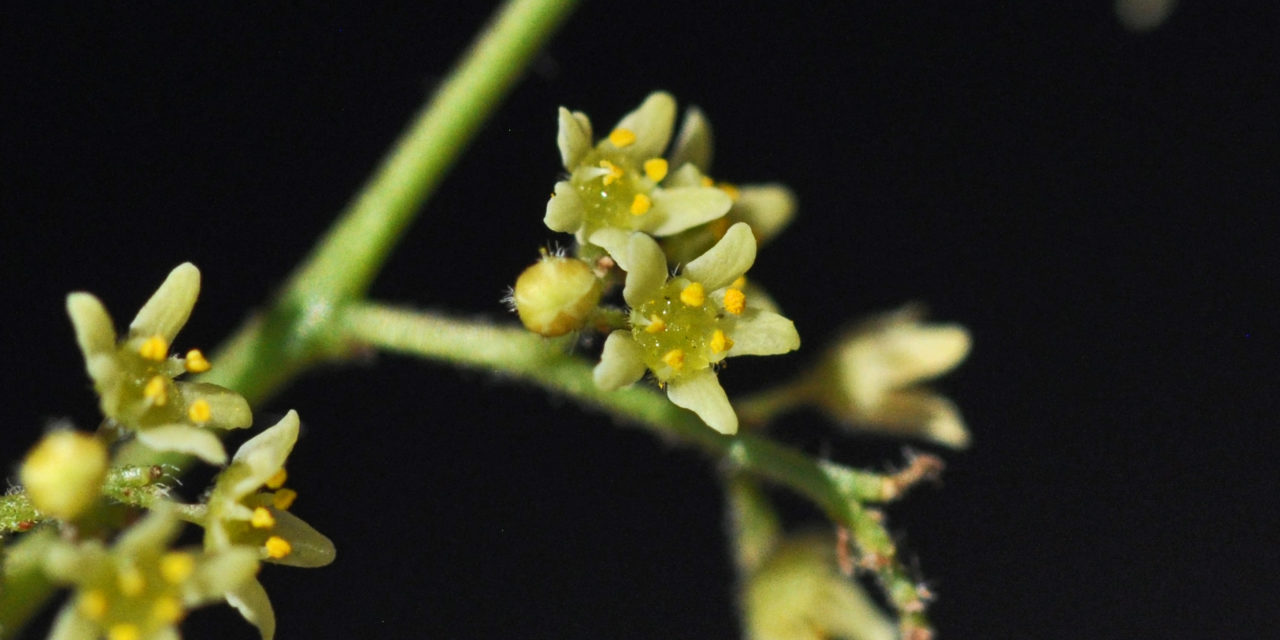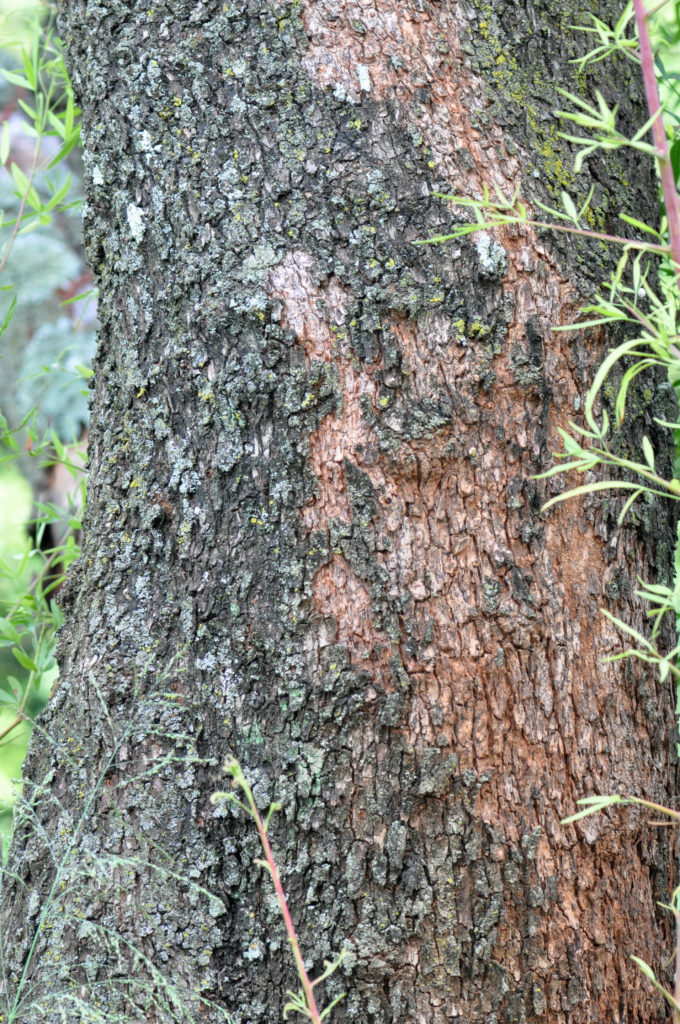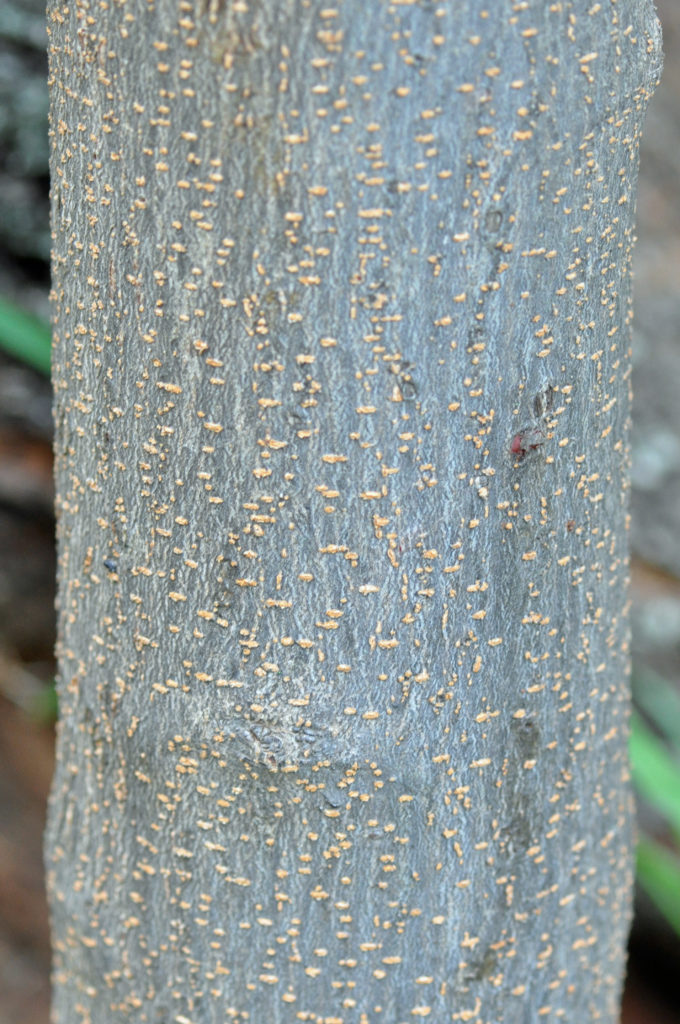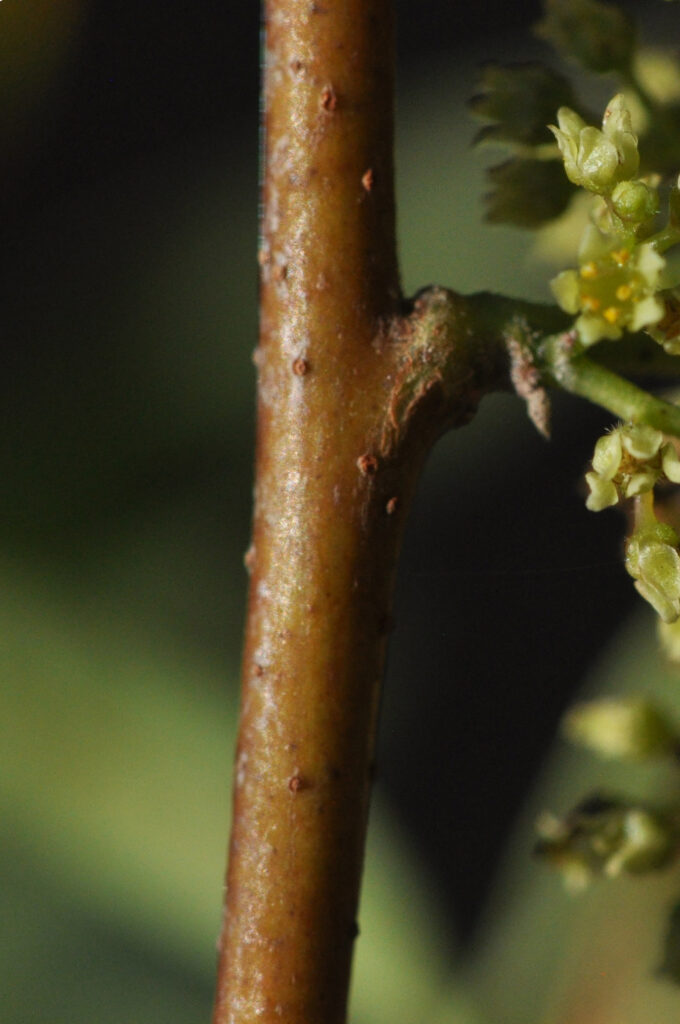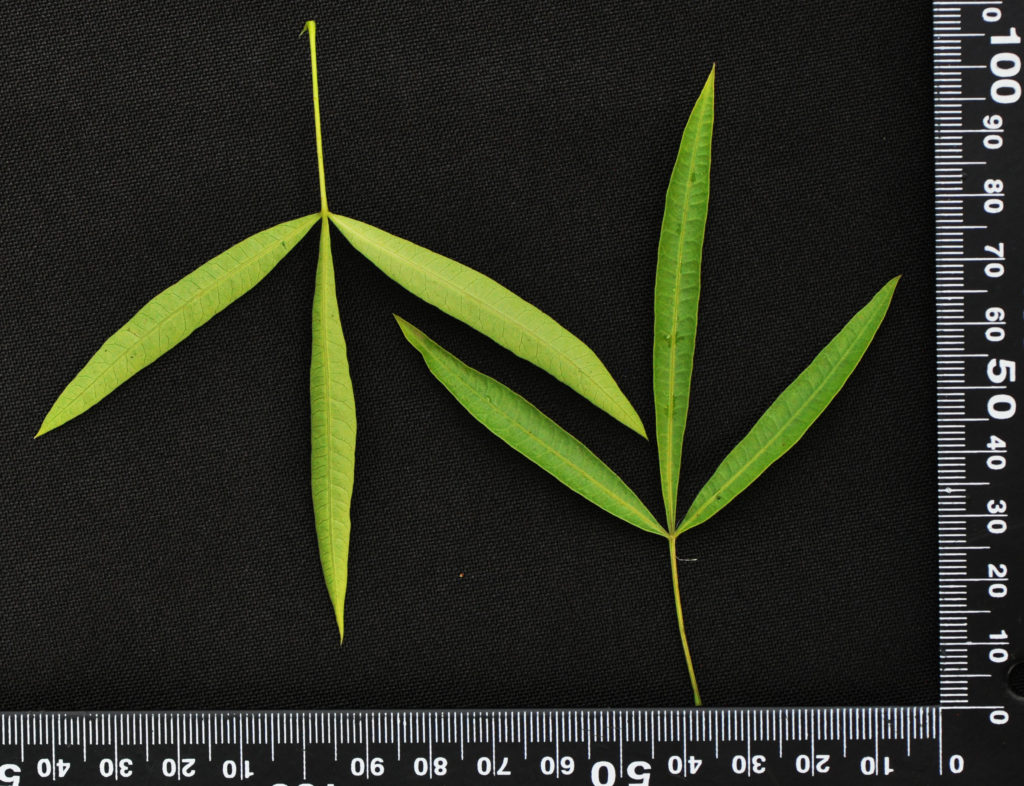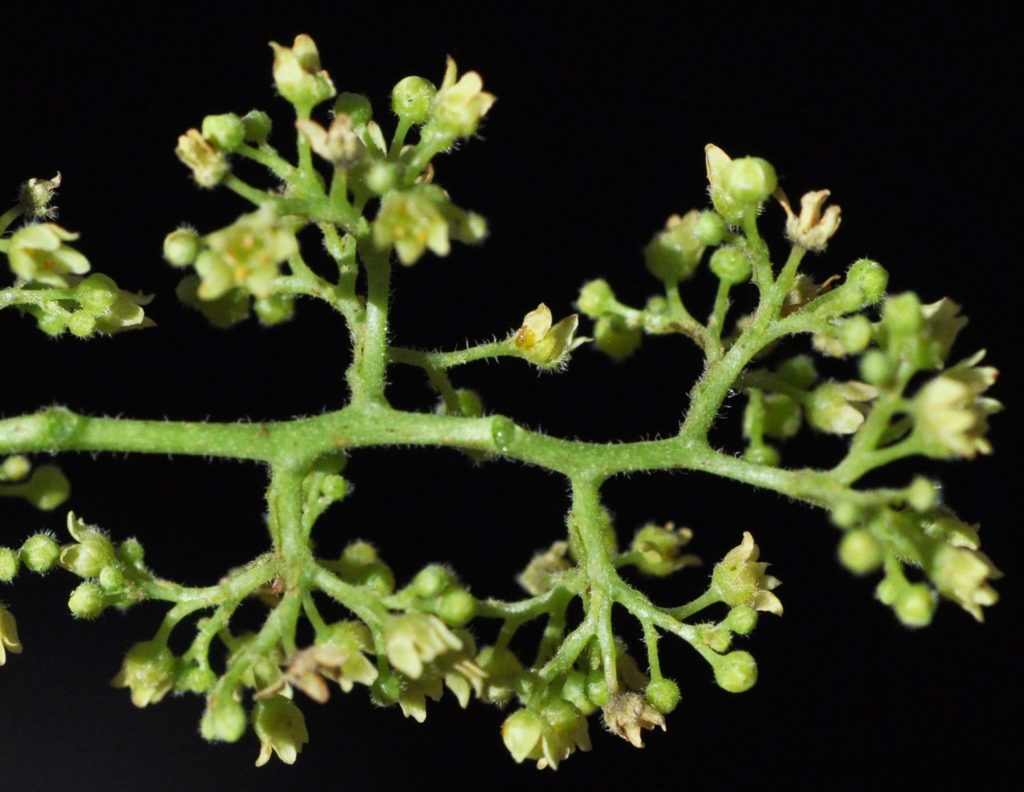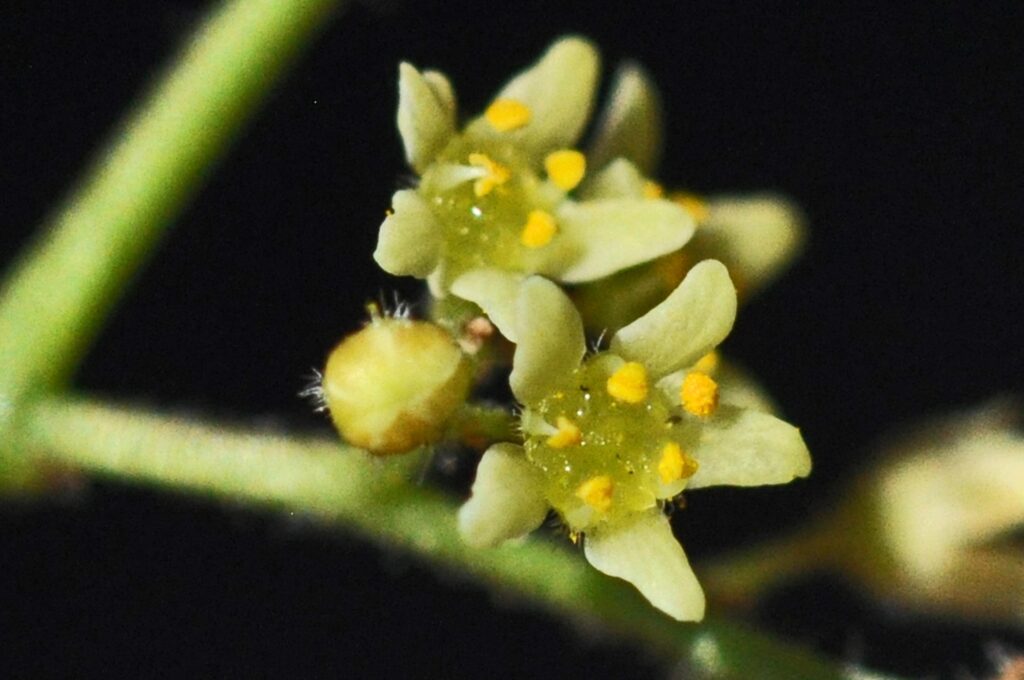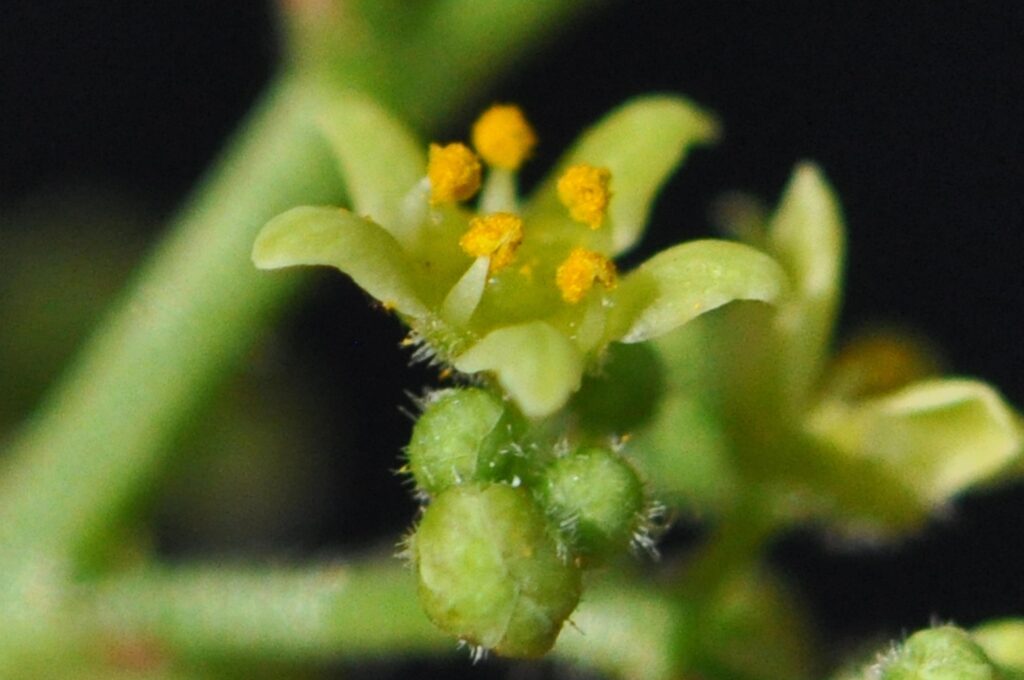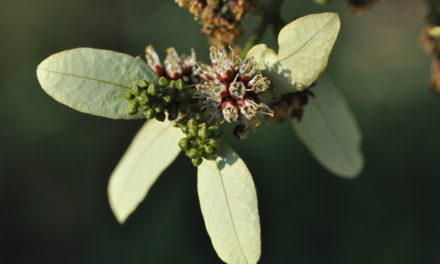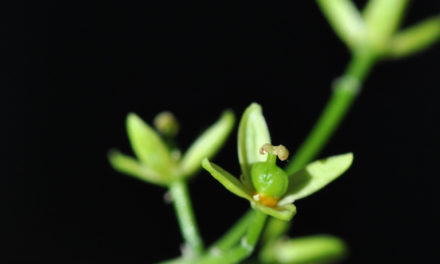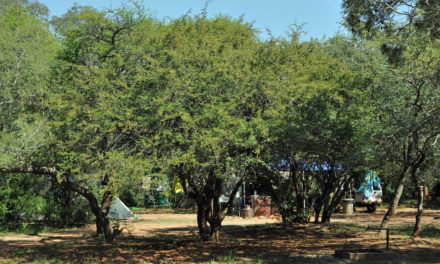General Info – summary
This sturdy, dioecious Tree with its narrowish trunk and smooth branches may reach 9m high. Spines and lenticels may be present on young branches. The trifoliate, hairless Leaves have sharp pointed narrow leaflets with entire margins. Unisexual, regular, tiny, 5-merous Flowers are in panicles. Male with 5 stamens, Female: 1 pistil with a superior ovary & 3 capitate stigmas. Fruit is a small, single seeded drupe.
Description
Searsia pendulina
Previous Names: Rhus pendulina, Rhus viminalis.
SA Tree No. 396.
Common name: (Afr) Kareeboom, Kareehout, Rivierkaree, Rosynebos, Rosyntjiebos, Witkaree, Witkareeboom, Wilderosyntjieboom. (Eng) River Karee, Western Karee, White Karee, Willow Karee. (IsiNdebele) Mosilabele.
Family: Anacardiaceae: (Mango family), which has about 83 genera and 850+ species – including Cashew). Resin canals are present and woolly stellate hairs cover all young parts. Leaves lack stipules. They may be deciduous or evergreen and usually alternate. Leaves are simple, trifoliate or digitally compound and imparipinnate. Leaflets are usually opposite. Crushed leaves may smell of turpentine. Trees are monoecious or dioecious with occasional bisexual Flowers. Flowers are small, usually regular. The Calyx has 4-7 sepals and there are 4-7 Petals. The number of Stamens is the same as, or twice the number of petals and the Anthers are versatile. The superior Ovary has up to 4 locules, each with a single ovule. The 1-5 Styles are free or connate and separated at the base. Fruit is usually an indehiscent fleshy drupe with a single Seed. The southern Africa genera containing trees on this website include Harpephyllum, Lannea, Loxostylis, Ozoroa, Sclerocarya and Searsia.
Name derivation: Searsia – named after Paul Bigelow Sears a highly qualified American ecologist (December 17, 1891 – April 30, 1990). He pioneered the study of fossil pollen in the USA. pendulina – hanging down – referring to the drooping branches. All of the many Searsia species in South Africa have edible fruit that is rich in carbohydrates.
Conservation: National Status: L C. Least Concern. Assessment: 2005 (W. Foden and L. Potter).
Tree
This sturdy, usually single-stemmed Tree is up to 9m high. It may also be a willow-like bush. Spines may be present on young branches. The tree has a spread of up to 5m. The Bark is initially smooth and brown, becoming rough and flaky with time (photo 870). The Branches are smooth, bendable and tend to droop. The Twigs (1-year-old current branch segments) are reddish (photo 329). Lenticels (a usually raised corky oval or elongated area on the plant that allows the uncontrolled interchange of gases with the environment) are present on young branches (photos 871 and 329).
- 870 2018.03.01 Pretoria NBG. Photo: David Becking.
- 871 2018.03.01 Pretoria NBG. Photo: David Becking.
- 329 2017.10.02 Pretoria NBG. Photo: David Becking.
Leaves
This evergreen tree has Leaves that are trifoliate (compound leaves with 3 leaflets). Each hairless, sessile Leaflet is narrow and lanceolate (simple longish leaf with a lance like head). The central leaflet is the longest (photo 875) – up to about 9 x 1,5cm. The Apex is pointed and may end in a spine-like tip (photo 877). The Base is narrow and tapering. Unlike S. lancea in which the leaflets are a light colour below and much darker above, the leaflets of S. pendulina are a similar dull fresh green above and only slightly lighter below (photo 875). The Midrib is ridged on both sides. Lateral veins usually divide into 2 just before reaching the margin. They are visible especially when viewed against a strong light (photo 877). The untoothed Margin may be slightly wavy, with short hairs and is entire (with a continuous margin, not in any way indented – photo 877). The slender Petiole (leaf stalk) is up to 4cm long.
- 875 2018.03.01 Pretoria NBG. Photo: David Becking.
- 877 Pretoria NG. 2018.08.17. Photo: David Becking. Leaflet against sun.
Flowers
This plant is dioecious (having male and female parts on separate plants). Green hairy buds (photo 442) are almost spherical. The tiny, unisexual, 5-merous Flowers are actinomorphic (Regular, symmetrical. Flowers are vertically divisible into similar halves by more than 1 plane passing through the axis). The many flowers are in Panicles (indeterminate, branched inflorescence with stalked flowers – photo 75). Flowers occur in dense sprays at the ends of branches or in leaf axils. In Male Flowers the 5 Stamens (photo 671) have Anthers that are versatile (hung or attached near the middle, and usually moving freely photo 442). A rudimentary ovary is present. In the Female Flowers, the Pistil (a unit of the gynoecium, composed of the stigma, style and ovary) is present. Three capitate (formed like a head) Stigmas are also present. Usually 5 Staminodes (sterile stamens) are visible. (Sep-Mar).
- 75 2019.09.27 Pretoria NBG. Photo: David Becking. Slightly dissected.
- 671 2018.05.29 Pretoria NBG. Photo: David Becking.
- 442 2019.08.29 Pretoria NBG. Photo: David Becking.
Fruit
The Fruit is a small almost spherical or ovoid Drupe (a fleshy, 1-seeded indehiscent fruit with the seed enclosed in a stony endocarp; stone fruit – like a peach). It is initially reddish and matures to a black colour. The single Seed is small – up to 3mm in diameter, roundish and not flattened as in S. lancea. Seeds lack albumen (commonly used in the sense of endosperm, for the material surrounding the embryo). (Dec-May).
Distribution & Ecology
This plant is endemic (restricted to a particular geographic location) in Southern Africa. These trees usually occur in arid areas – e.g. along the Orange River, in the Northern Cape – almost to its mouth. They also occur in the western Free State and in southern Namibia. Trees that grow alongside this tree include Diospyros lycioides, Olea Vachellia karroo, Salix mucronata and Ziziphus mucronata. Searsia pendulina is a great shade tree in this hot dry area. Other South African great shade trees include Olea europaea subsp. africana, Searsia lancea, Vachellia erioloba and Pappea capensis. Searsia pendulina tolerates high and low temperatures and even excess water. Birds are attracted to the Fruit and many butterfly larvae consume the leaves – including the Namaqua Arrowhead Phasis clavum. This butterfly usually has a flight period from Sep – Nov.
Ethnobotany
The Wood is long lasting and is used for fence poles and hut construction. It is not large enough to be used for planks. The Bark can be used for tanning – giving a reddish-brown colour. Branches have been used to construct baskets and useful bows. The twigs are used to build fish traps. This plant, with its non-aggressive roots, has become sought after for parks and gardens. It is a fast-growing tree that can be Grown from seeds or cuttings. In order to obtain fruit, male and female trees must be reasonably close together. Here cuttings grown from existing male and female trees would ensure this. This plant does best in full sun. Leaves are consumed by domestic stock and are used in local medicine for stomach problems. The fruit is edible and is a local source of carbohydrates. Beer can be made from the fruit. This attractive tree can survive difficult times and will prosper when others do not – a worthwhile addition to almost any garden.
The poison ivy in South Africa is Smodingium argutum and that from Asia and North America is in the genus Toxicodendron. Both are in the same family as our Searsia species: Anacardiaceae. Apart from Searsia pyroides whose spines may cause a burning sensation, no other species of Searsia are poisonous.
References
Coates Palgrave, M. 2002. Keith Coates Palgrave Trees of Southern Africa, edn 3. Struik, Cape Town.
Foden, W. & Potter, L. 2005. Searsia pendulina (Jacq.) Moffett. National Assessment: Red List of South African Plants version 2020.1. Accessed on 2022/05/04.
Palmer, E. & Pitman, N. 1972. Trees of southern Africa. Balkema, Amsterdam, Cape Town.
van Wyk, B. & van Wyk, P. 1997 Field guide to Trees of Southern Africa. Struik, Cape Town.
Woodhall, S. 2020. Field Guide to Butterflies of South Africa, edn 2. Donnelley, RR, China.
http://pza.sanbi.org/searsia-pendulina
https://en.wikipedia.org/wiki/Searsia_pendulina

